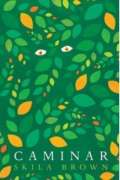
Carlos knows that when the soldiers arrive with warnings about the Communist rebels, it is time to be a man and defend the village, keep everyone safe. But Mama tells him not yet — he’s still her quiet moonfaced boy. The soldiers laugh at the villagers, and before they move on, a neighbor is found dangling from a tree, a sign on his neck: Communist. Mama tells Carlos to run and hide, then try to find her. . . . Numb and alone, he must join a band of guerillas as they trek to the top of the mountain where Carlos’s abuela lives. Will he be in time, and brave enough, to warn them about the soldiers? What will he do then? A novel in verse inspired by actual events during Guatemala’s civil war, Caminar is the moving story of a boy who loses nearly everything before discovering who he really is. Set in 1981 Guatemala, a lyrical debut novel tells the powerful tale of a boy who must decide what it means to be a man during a time of war.
- ISBN: 9780763665166
- Authors: Brown, Skila; Brown, Skila
- Published: 2014, Candlewick
- Themes: brave, decisions, discovery, Family, Inspirational, Search, Soldiers, Villages
- Descriptors: Fiction, Guatemala, Historical Fiction, Intermediate (ages 9-14), Poetry
- No. of pages: 208

Michelle
Written as a novel in verse, Caminar walks readers through young Carlos’ experience during Guatemala’s civil war in 1981. Carlos who is “old enough to feed the chickens, gather eggs by myself . . . but Mama would not let me wring their necks. ‘not yet,’” finds himself caught between the government’s soldiers and the rebels. Life had been peaceful for Carlos and his mother in their village until one day the soldiers come to warn them of the “Communist rebels.” Initially distanced by the conflict, Carlos decides, he must be a man and “keep the village safe” from the rebels but when rebels arrive, he is not sure which group to trust. The decision is made clear when the army solders return to destroy his village and his people. Left alone to survive in the forest, Carlos joins a group a rebels and must warn his grandmother’s village in the mountains of the danger to come.
I found myself immersed in Carlos’ world, drawn into his own coming of age conflict as well as the conflict created within the historical context. The atrocities of war experienced by Carlos was disturbing but the strength and courage he found within himself was amazing. It was interesting to note how his nahuales or his animal spirit protector, guided him through his journey into manhood. This reminded me how animal spirit protectors are portrayed in different indigenous cultures. For example, in Hawaiian culture they are called `aumakua which helps or provides guidance for family members throughout their lives. For Carlos, the owl appeared at pivotal points in his journey to guide or forewarn him of danger. I liked how Brown’s skillful use of nahuales was a believable part of the story. As a narrative poem I found that it was a quick read, yet the author’s use of the form – white space, repetition, imagery, and word choice led me to pause and reread to experience the power of her words. I think that Caminar shares an important part of Latin America’s history in a compelling and accessible way for middle school readers.
Yoo Kyung
I am glad Caminar came out this year. After Libertad (2008), by Alma Fullerton, there were not many Guatemalan children’s stories published for upper elementary students. Most of what I have read about children caught up in civil wars are set in Africa and contain graphical descriptions of atrocities more appropriate for young adults than upper elementary readers. Skila Brown captured well young Carlos’ feelings of fear, anxiety, sadness, and pride (in helping provide others’ security) as he is caught up in Guatemala’s civil war. Carlos’s weeping heart was well expressed in controlled and symbolic analogies as he learned about the tragedy that befell this mother and her village. The story focused on illustrating a boy’s hard journey during the Guatemalan civil war in 1981 while using Guatemalan cultural and linguistic expressions. Another theme I noticed is how Brown placed childness and childhood in a larger global context. The innocence and safety that any child deserves had been violated by national politics. Carlos’s friendship with other rebel children showed him doing his best to protect them and allowed the reader to see that childness has a power of resilience that grown-ups cannot always provide. There is also a beauty in the free verse writing format. Caminar is like a “crouching novel hidden in concrete poems.” The expressive language evoked sounds and feelings, sketching heartbeats, surroundings, and ecological conditions that Carlos feels and sees. Brown’s moving and dancing free verse narratives reminded me of Paul Fleischman’s two voice poems. Brown also provided a sense of humor to ameliorate the heavy topic of the story. It makes a good global read for young readers.